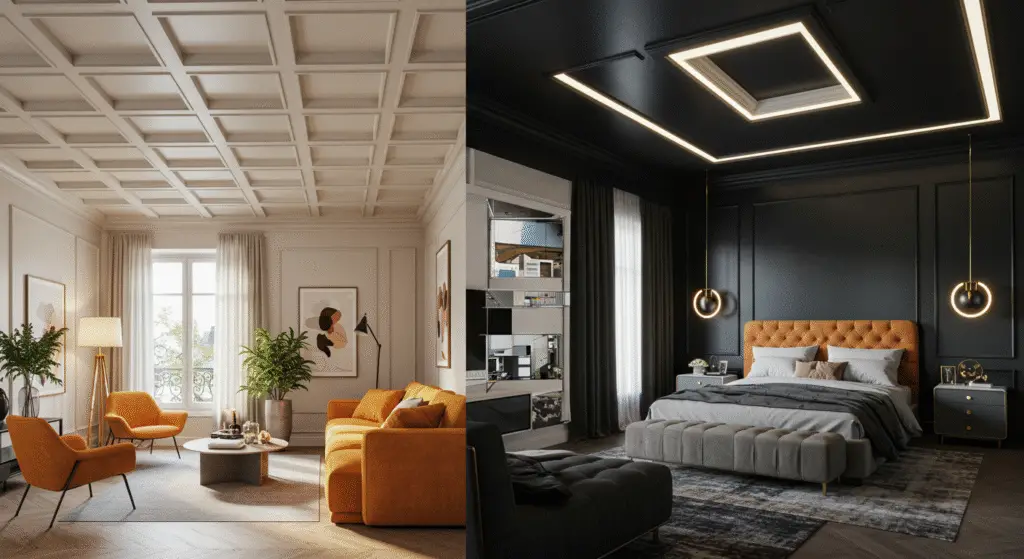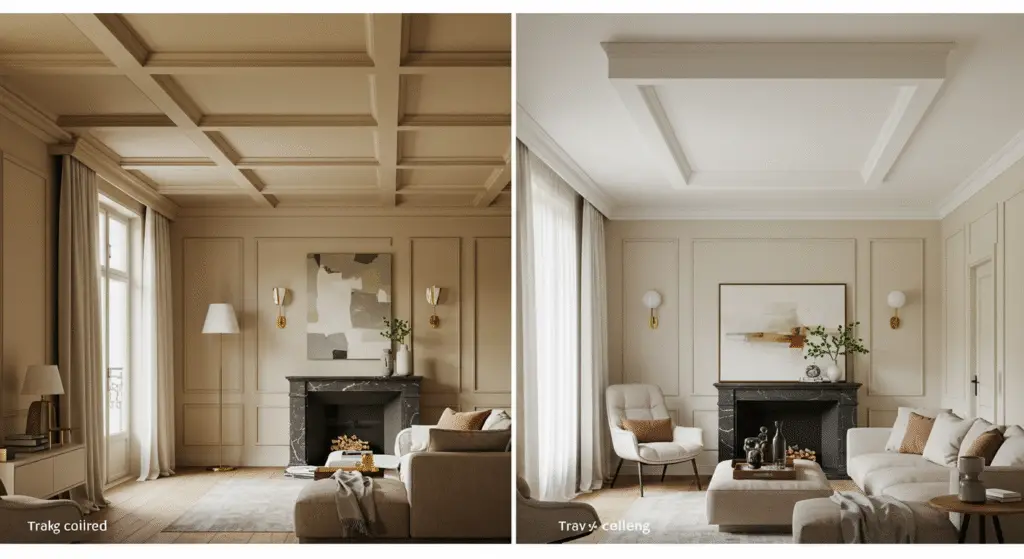
When designing or renovating a home, one often overlooked but incredibly impactful element is the ceiling. Among the many styles available, coffered vs tray ceiling options are some of the most popular and frequently compared. Choosing between them can influence not just how a space looks, but also how it feels, functions, and even how it’s valued in the real estate market.
In this blog post, we’ll break down everything you need to know to make an informed decision between coffered and tray ceilings—from architectural style and cost to installation and lighting flexibility.
Understanding the Basics
Before diving into a detailed comparison, it’s helpful to understand what each ceiling type really is.
A coffered ceiling features a series of sunken panels arranged in a grid pattern, often square or rectangular. These panels are usually bordered by beams, adding depth and a strong architectural presence.
A tray ceiling, on the other hand, has a central raised section that steps upward from the flat ceiling edges, forming a “tray-like” shape. It’s less elaborate but adds subtle sophistication to any room.
Both styles aim to break the monotony of flat ceilings, but they do so in distinct ways that can suit different design goals.
Design Aesthetics and Visual Impact
Choosing the right ceiling style can dramatically change the mood of a room. A coffered ceiling brings a classic, elegant, and sometimes even dramatic touch to interiors. It works exceptionally well in formal spaces like dining rooms, libraries, or offices. The grid pattern of beams draws the eye upward, making the room feel structured and grand.
Tray ceilings are more versatile in design. They offer a cleaner, more modern look and can be enhanced with lighting or painted trim for additional flair. They’re commonly used in bedrooms, living rooms, and bathrooms because of their soft, layered appearance.
So when it comes to visual impact, think about whether you want bold structure or gentle depth. Your choice can influence not only the room’s style but also how people feel when they enter the space.
Budget Considerations
Budget often plays a major role in design decisions, and comparing coffered vs tray ceiling styles reveals a noticeable cost difference.
Tray ceilings are generally more affordable. They involve less material, less labor, and simpler construction. Many homeowners with some DIY experience can even tackle a basic tray ceiling project themselves.
Coffered ceilings, due to their complexity, are more expensive to build. Each recessed panel must be framed and finished carefully, which increases both labor time and material cost. Custom coffered ceilings, especially those using real wood, can significantly raise the budget.
That said, coffered ceilings also add more resale value in most cases because of their luxurious appeal.
Suitability for Ceiling Heights
Not all rooms are built the same, and ceiling height can be a deciding factor. Coffered ceilings require more vertical space to work properly. If your room has a low ceiling, installing coffered panels may make the room feel cramped instead of elegant.
Tray ceilings are more flexible and are often recommended for rooms with standard ceiling heights. They create the illusion of additional height while still keeping the space feeling open and airy.
If you’re working with ceilings that are 9 feet or higher, you can choose either style depending on your taste. For ceilings lower than 9 feet, a tray ceiling is usually the better option.

Lighting Flexibility
One of the most attractive benefits of tray ceilings is how well they work with modern lighting designs. Cove lighting—LED strips hidden along the inner edge—can add a warm, ambient glow to the entire room. This type of lighting is both stylish and energy-efficient, making tray ceilings a popular choice for bedrooms and living areas.
Coffered ceilings also offer unique lighting opportunities. Recessed lighting can be placed within each panel, and central fixtures like chandeliers can be positioned within one of the coffers. This layout provides a more traditional and stately form of illumination.
Both ceiling types offer excellent lighting potential, but the style of lighting you prefer can guide your choice.
Material and Finish Options
Coffered ceilings can be built from a variety of materials including wood, MDF, or even plaster. Wood creates a classic, timeless appearance, but it’s also the most expensive and requires ongoing maintenance. MDF is more budget-friendly and easier to install while still offering an attractive finish.
Tray ceilings are typically finished with drywall and painted to match or contrast the rest of the room. They can also include crown molding or wood trim for extra visual appeal.
If you’re looking for high customization and a rich, layered texture, a coffered ceiling is ideal. If you want a simpler finish that still stands out, a tray ceiling might be the right fit.
Where Each Style Works Best
Both coffered and tray ceilings can be used in almost any room, but some placements make more sense than others.
- Living Room: A tray ceiling can enhance cozy vibes, while a coffered ceiling adds grandeur.
- Bedroom: Tray ceilings are usually preferred for their calm, understated elegance.
- Dining Room: Coffered ceilings are perfect for creating a formal, luxurious setting.
- Home Office or Library: A coffered ceiling gives these spaces a serious, traditional tone.
- Bathroom: A tray ceiling can give the illusion of more space and luxury without overwhelming the room.
Your decision should be guided not just by appearance but by how the room is used and what feeling you want to create.
Installation Difficulty
If you’re considering doing the work yourself or just curious about the process, it’s important to know the difference in installation complexity.
Tray ceilings are relatively simple to design and build. They involve framing out a recessed box and covering it with drywall. Even a modestly experienced contractor—or advanced DIYer—can complete the project efficiently.
Coffered ceilings are more demanding. They require precise measurements, multiple framing steps, and detailed finishing work. In most cases, hiring a professional is necessary to get the polished look these ceilings are known for.
Long-Term Maintenance
Tray ceilings are low-maintenance. Once installed and painted, they rarely need anything beyond occasional dusting or repainting.
Coffered ceilings, especially those made of wood, may need more frequent attention. Dust can accumulate in the recessed areas, and the beams might need refinishing over time. However, modern materials like faux wood can help reduce maintenance needs without sacrificing the look.
Final Thoughts
When choosing between coffered vs tray ceiling styles, consider your home’s architecture, your budget, and the function of the space. Each ceiling type offers a unique blend of beauty and practicality.
Tray ceilings are modern, cost-effective, and work well in a variety of room sizes and styles. Coffered ceilings deliver timeless elegance and architectural depth but come at a higher cost and require more installation effort.
Think about what mood you want to create and how much you’re willing to invest. With the right ceiling choice, you can transform a basic room into a stunning, memorable space.
